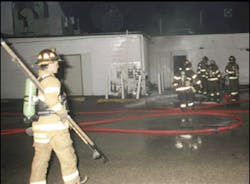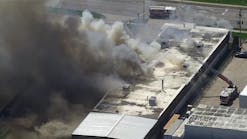As the engine officer finds that the door can be opened easily in this scenario, a heavy push of black smoke about waist level meets the engine. Heat conditions are starting to drop and can be felt pushing from the rear. While slowly advancing low and inward directing the straight stream above and to the rear, the officer can hear the glass breaking and the forcing of the back door. Smoke and heat conditions start to lift. Now only five feet in the door the engine pauses, and the officer makes a very experienced decision to move up another firefighter just past the nozzle with a pike pole (or plaster hook) to pull ceiling. Although the heat momentarily lifted, the officer can feel the heat returning to push against them. The officer had started to do some fast and experienced calculation:
hose stream + ventilation + building construction + conceal space fire + heat conditions = PULL CEILING (fire may be over head!).
While positioning just several feet ahead of the nozzle, the firefighter starts to punch through the ceiling. That first punch into the ceiling will tell much of the story:
- How difficult was it to break into the ceiling?
- Did whole sections of ceiling freely drop?
- Did the pole virtually bounce back off the ceiling (maybe indicating tongue and groove)?
- Once a hole has been made, can a "new" push of heat be felt indicating approaching fire?
- Does fire drop through the ceiling as soon it is pulled?
It is important that the officer be positioned near the nozzle behind the firefighter about to pull ceiling:
- It is understood that generally it is not safe to operate ahead of the nozzle during a fire attack, but it is necessary in this case.
- It is important to position the nozzle BEHIND the firefighter with the pike pole! Allowing a firefighter to pull ceiling from behind the nozzle will allow falling ceiling to drop on head of the nozzle position, and the stream protection is limited as the hole would be made directly over the nozzle position. In addition, once water is delivered and worked straight up and overhead of the engine company, whatever water drops back down might be scolding.
- The nozzle positioned slightly behind the firefighter pulling ceiling, allows for water protection. Should the firefighter need to be protected from falling ceiling and concealed space fire that is released that starts to rapidly spread, the stream can be operated overhead once the firefighter with the pole quickly turns and moves back several feet out of harms way.
- Situations have occurred were concealed space backdrafts have resulted when the 'interior truck' has opened up ceiling and wall spaces. Retired Chicago FD District Chief Bennie Crane relates that experience as a firefighter on a truck company. In an old plaster and lath ordinary constructed apartment building the nozzle was positioned the hallway and the smoke pushing from the ceiling of an adjoining room was unusual. As he had entered the room he was ordered to pull the ceiling. The next thing he remembered was being picked up from the hallway floor after the engine company crawled over him to knock down heavy fire in the room he had just pulled ceiling in - a concealed space backdraft had occurred.
The firefighter working as the 'interior truck' should be trained on selecting the right type of pole or hook for the type of building being entered:
- The 6-foot pole might work in a certain type of building with 8-foot ceilings, but when dealing with higher ceilings in such buildings as commercial, institutional, office, or industrial it should be obvious that 8-foot and even 10-foot poles need be used. The 'interior truck' should NOT be thinking of pulling ceiling straight down dropping debris on top of everyone, but angling the pole to drop ceiling ahead of their position. In many such cases the 6-foot pole would be too short.
- Another reason for a longer pike pole is it might not always be possible to stand upright because of the heat conditions. If having to pull ceiling while kneeling, several feet of pole length will be lost to reach the ceiling and might call for an 8-foot rather than a 6-foot pole.
- If not sure of the type of building interior (e.g., given construction modifications, lightweight construction with cathedral ceilings, etc.), take two different poles to the building.
- Given the building construction, the design of the pole is also important. In many cases the plaster hook is very effective for drywall sheets, whereas a different hook would be needed for a commercial tin ceiling.
In the earlier fire attack scenario the officer was experienced enough to assign a firefighter to be 'interior truck' with the engine operation to pull the ceiling before advancing any further. Given the smoke and heat conditions, had the officer become victimized by "tunnel vision", they would have crawled under and passed heavy fire overhead in the ceiling. The result could have been disastrous as fire could have dropped with the ceiling behind them. The coordination of aggressive ventilation, an adequate size hose line, and pulling ceiling when needed during the fire attack are some to the greatest assurances in the name of safe and effective basic firefighting.






